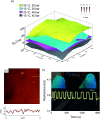Flexible transparent graphene laminates via direct lamination of graphene onto polyethylene naphthalate substrates
- PMID: 36134291
- PMCID: PMC9416925
- DOI: 10.1039/d0na00046a
Flexible transparent graphene laminates via direct lamination of graphene onto polyethylene naphthalate substrates
Abstract
Graphene, with its excellent electrical, mechanical, and optical properties, has emerged as an exceptional material for flexible and transparent nanoelectronics. Such versatility makes it compelling to find new pathways to lay graphene sheets onto smooth, flexible substrates to create large-scale flexible transparent graphene conductors. Here, we report the realization of flexible transparent graphene laminates by direct adhesion of chemical vapor deposition (CVD) graphene on a polyethylene naphthalate (PEN) substrate, which is an emerging standard for flexible electronics. By systematically optimizing the conditions of a hot-press technique, we have identified that applying optimum temperature and pressure can make graphene directly adhere to flexible PEN substrates without any intermediate layer. The resultant flexible graphene films are transparent, have a standard sheet resistance of 1 kΩ with high bending resilience, and high optical transmittance of 85%. Our direct hot-press method is achieved below the glass transition temperature of the PEN substrate. Furthermore, we demonstrate press-assisted embossing for patterned transfer of graphene, and hence it can serve as a reliable new means for creating universal, transparent conducting patterned films for designing flexible nanoelectronic and optoelectronic components.
This journal is © The Royal Society of Chemistry.
Conflict of interest statement
There are no conflicts to declare.
Figures





References
-
- Bonaccorso F. Sun Z. Hasan T. Ferrari A. C. Nat. Photonics. 2010;4:611. doi: 10.1038/nphoton.2010.186. - DOI
LinkOut - more resources
Full Text Sources

